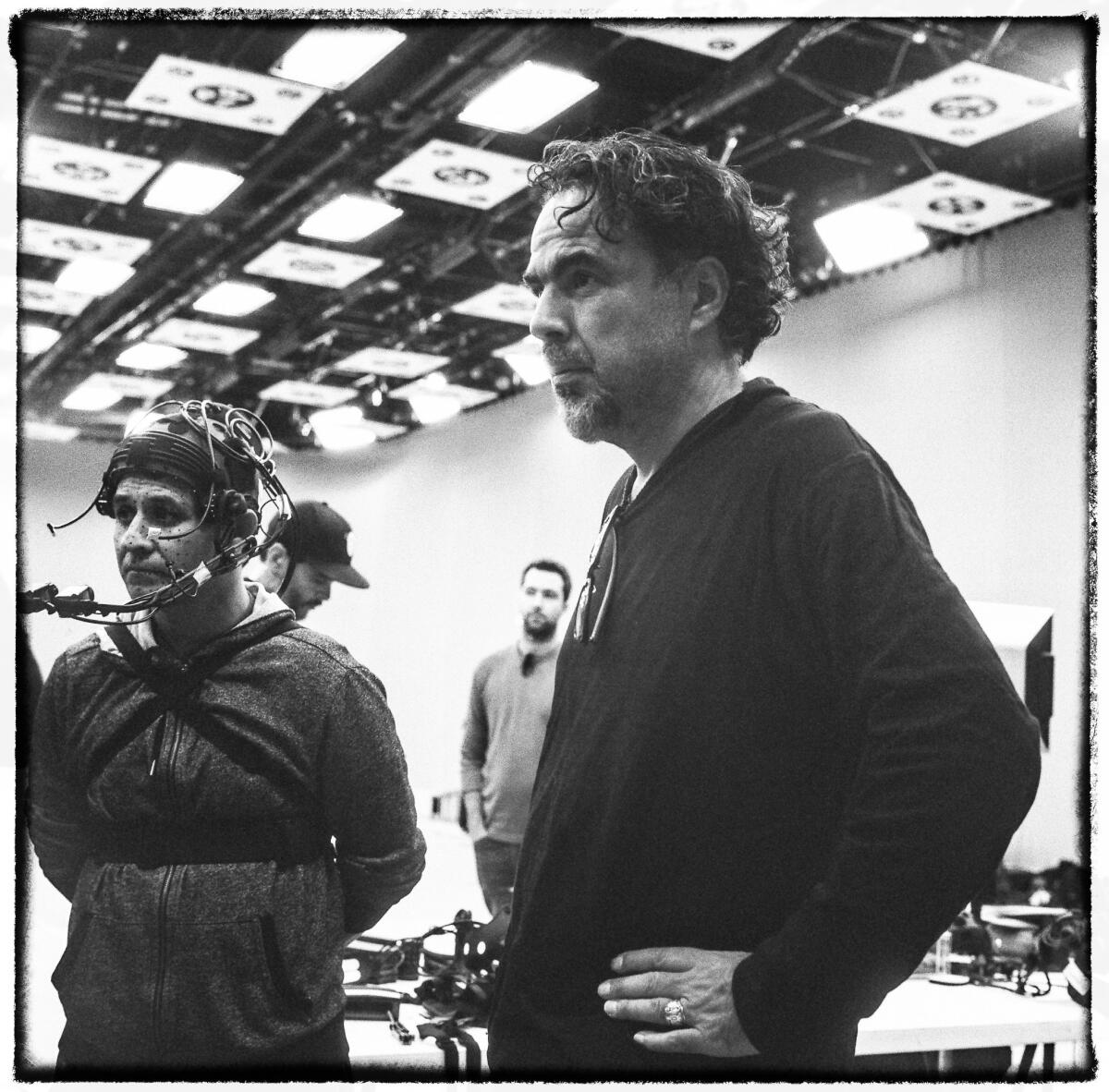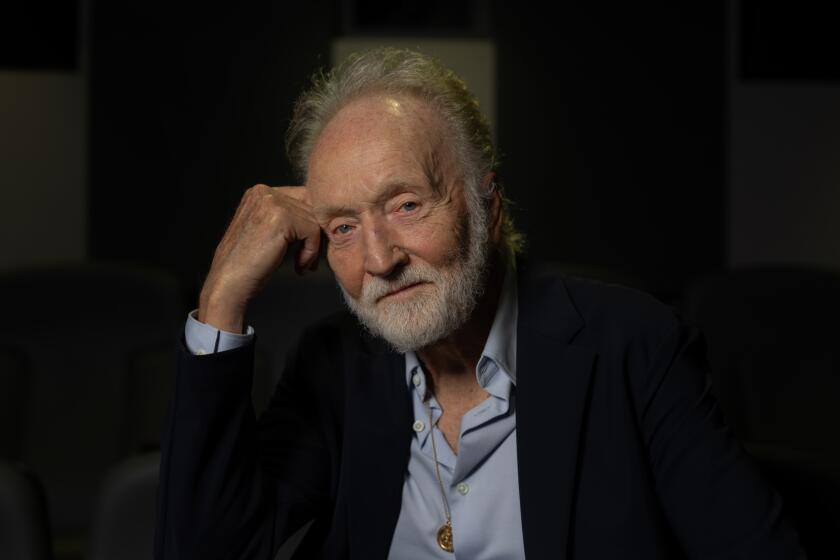Cannes 2017: Alejandro Iñárritu’s virtual reality project takes film to new frontiers—and questions
As virtual-reality entertainment began to gain currency over the last few years, two key questions have emerged: Will the mainstream film community embrace it? And in what form?
The first question is increasingly heading to an emphatic yes, underscored most recently at this year’s Cannes Film Festival, where organizers for the first time included a VR project in its Official Selection.
Alejandro G. Iñárritu’s ”Carne y Arena,” by the Oscar-winning director of “Birdman” and “The Revenant,” is a multi-platform experience that includes a VR film; it is so sprawling the festival installed it in an airplane hangar 20 minutes outside downtown Cannes. The project has both Hollywood bona fides — it was partly funded by the studio heavyweight
Answers to the question about form, however, remain far more ambiguous.
“Carne y Arena” tells the story of Latin American immigrants attempting to cross into the United States through the Arizona desert when they are caught by U.S. authorities. Iñárritu and his frequent cinematography collaborator Emmanuel Lubezki, who goes by “Chivo,” located real people who suffered the torturous journey and had them reenact it on camera; they then shot their stories with VR's 360-degree sweep and in-your-face urgency.
Until you feel it — until you feel what it's like to be 20 years old, not left wing or right wing or any wing — you can't really talk about it.
— Alejandro G. Iñárritu, director of the VR project 'Carne y Arena'
Viewers experience the film in a highly curatorial way. The piece is flanked by an art installation — on-screen testimony, a reconstructed holding pen — while the movie itself is a “walking” VR piece that allows the audience members to wander around the desert, a sand-strewn space the size of several volleyball courts, wearing Oculus Rift head sets. A version will come this summer to the
The six-minute piece begins with a desperate group of immigrants straggling into sight, led by their "coyote" smugglers. But the windswept quiet is soon jolted by a heavens-rattling military helicopter. In an instant, the terrain is turned into a “Children of Men”-style horror show. As guns are pointed and orders barked, the immigrants drop to their knees. So too can the viewer; the virtue of VR is the ability to walk up to and around a film's subjects, almost like one holds an invisibility force field.
“This is very different from the rhetoric and the politics,” Iñárritu said in a joint interview with Chivo on the first Sunday of the festival. “Until you feel it — until you feel what it's like to be 20 years old, not left wing or right wing or any wing — going through something like this, you can't really talk about it.”
The subject matter is not new to VR. Border stories have been explored for years by many of the medium's preeminent filmmakers (especially the former USC pioneer Nonny de la Peña), and the air of novelty put forth by those promoting the project will be met by VR veterans with a measure of skepticism.
What Iñárritu has done differently is offer a sense of scope and scale — much like a studio director who adapts the techniques of an independent filmmaker to a bigger canvas. There is an almost unprecedented vastness to the desert, which can seem peaceful until the cavalry arrives and turns it into a kind of wasteland prison. The use of a comparatively large budget (undisclosed) and whiz-bang technology also offers a level of hyper-realism that would have been unthinkable to filmmakers working with different tools or a shallower pocketbook.

We came in with two cameras thinking we'd block everything and then shoot it. And we realized that was very naive.
— Emmanuel Lubezki, cinematographer
Beyond the question of the border story, whether documentary-style pieces are ideally suited for VR generally remains to be seen. Dropping a viewer into the action is one of the chief assets of the medium, making the documentary style a no-brainer. Whether it also is the most compelling — not to mention the most commercial — is another matter. Given their resumes, Iñárritu and Chivo might have seemed apt to press a fictional narrative — something live-action VR has been sorely missing — though, when asked, the pair hedged on whether they'd try that next.
Still, the filmmakers would seem well disposed to VR from a technical standpoint, having used 360-degree camera techniques in “The Revenant” and “Birdman,” in which they at once broke cinema’s frame and worked within it. This time around they had no frame to break, just a cover-every-pixel process they described as being as vexing as it was liberating.
“It’s a completely different medium. You can’t use the tools we’ve developed in film for over 100 years,” Chivo said. “We came in with two cameras thinking we’d block everything and then shoot it. And we realized that was very naive.”
To hear the pair talk with fresh wonderment about the form — the need for new grammar and the obsolescence of old techniques, the flouting of convention and the different rules of consumption — is to listen to conversations that many in the VR community have long had and, in a sense, moved past.
Still, such remarks are noteworthy. They offer a glimpse at the sometimes uneasy dynamic that occurs when the artistic establishment in one form begins discovering another, like when rock musicians first stumbled upon an already thriving world of hip-hop beats.
Hollywood and VR still need to work out cultural differences too. The notion is highlighted by the unusual layers of Hollywood bureaucracy around seeing “Carne” and interviewing principals at Cannes, which clashes with the informality and filmmaker accessibility that has until now characterized the space.
Even the matter of what to call these new pieces has been complicated — a point whose seeming insignificance is belied by the number of emails sent to journalists at Cannes exhorting them to call “Carne” an “art installation” instead of a film.
The presence of “Carne” at the festival makes for a tricky juxtaposition. Much of the Sturm und Drang at the festival around digital technology has been centered on Netflix, which with two films in competition has provoked a backlash from French theater owners and plenty of headlines. But in a way, streaming services are not the real disrupters. They may upset theater owners, but they keep intact many of the film industry's long-standing rules and players. Hollywood in the Netflix age is doing what it has always done, it is just delivering film differently.
VR, though, upends the game much more significantly, changing the very way stories are told and — since hardly every filmmaker is as game as Iñárritu and Lubezki — who will tell them too. That is far more anathema to the ideology of Cannes, which reveres cinema and its masters like few others. This makes it all the more surprising that festival director Thierry Frémaux enthusiastically persuaded a skeptical Iñárritu to bring the piece here (at least as the filmmaker explained it), instead of the other way around.
If VR takes off as a storytelling medium, the idea of people gathering in plush theaters named after French artistic greats to watch two-hour slices of edited film could seem as quaint as the masses gathering for the latest Bizet debut.
In that regard, at least, Iñárritu and Chivo are ahead of the curve when they say that VR could soon become a much bigger part of film fans’ diet.
“I think it could be less than 10 years when kids look at a movie on a [traditional] screen and say, ‘You used to watch things on that?’” Chivo said.
In the meantime, filmmakers are ranging around to match content and medium.
“We are using the highest technology to express the stories of the people treated like the lowest in society,” Inarritu said. “It is virtual reality to express a bad reality."” What other kinds of reality — and whether it needs to be real at all — still needs to be sussed out. Maybe at future festivals.
See the most-read stories in Entertainment this hour »
Twitter: @ZeitchikLAT
ALSO
Netflix's first movie appears at Cannes, and so does the controversy
Sharing a Coke and memories at Cannes with Kuberick whisperer Leon Vitali
Cannes 2017: ‘The Square’ director Ruben Ostlund talks of moral dilemmas as cinematic experience
Only good movies
Get the Indie Focus newsletter, Mark Olsen's weekly guide to the world of cinema.
You may occasionally receive promotional content from the Los Angeles Times.








